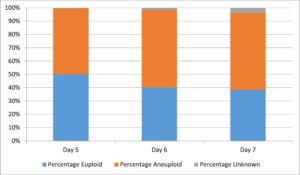
OBJECTIVE:
To compare ploidy rates amongst day 5, 6, and 7 blastocysts.
DESIGN:
Retrospective study in a private in vitro fertilization laboratory.
AIM:
Some data suggests that Day 7 (D7) blastocysts can give rise to nearly 27% ongoing pregnancy success by frozen embryo transfer (Kovalevzky et al., 2013). We chose to compare the aneuploidy rate observed amongst day 5, 6, and 7 blastocysts in order to determine the efficacy of extended D7 culture in our laboratory.
MATERIALS AND METHODS:
Over the span of 3 years, a total of 1915 blastocyst stage embryos (average maternal age of 37 ± 4.1 years) underwent trophectoderm biopsy for genetic testing of ploidy status. Pre-implantation genetic screening (PGS) results were retrospectively compared to day of trophectoderm biopsy. Mature oocytes were fertilized using ICSI and embryos were group cultured in a continuous single culture medium (Irvine Scientific). On Day 3 of embryo development, all multi-cell embryos (≥6 cells) were artificially hatched by laser ablation of the zona pellucida. Hatched embryos were then cultured to the blastocyst stage. Trophectoderm biopsy was dependent on development of a well-defined inner cell mass and trophectoderm. Hatching or completely hatched blastocysts were biopsied on either Day 5, 6 or 7 and subsequently vitrified for future use in a warmed embryo transfer cycle dependent on ploidy status. Biopsied samples were analyzed with comprehensive chromosomal screening involving the use of array comparative genomic hybridization (aCGH) or next generation sequencing (NGS) technology by a reference laboratory.
RESULTS:
1915 embryos were biopsied yielding a total of 862 (45%) euploid embryos: 485(56%), 328(38%) and 49(5.7%) from D5, D6, and D7, respectively. The incidence of euploidy was 50%, 40%, and 38% among D5, D6, and D7. Chi-square analysis demonstrated that euploid status is dependent on day of biopsy/blastocyst development with chi square statistic calculated to be 17.5847 and a P value < 0.0001 (Figure 1).

CONCLUSION:
Embryos biopsied on day 5 and 6 have a significantly higher probability having normal chromosome complements compared to day 7 embryos as a whole. These results contradict previous reports of D5 and D7 blastocysts contributing equal numbers of euploid embryos (Vaccari et al., 2014). Our findings suggest that perhaps a delay in blastulation (until D7) may be associated with a greater likelihood of aneuploidy. Despite this, culturing embryos to D7 appears to be beneficial as a substantial number of blastocysts biopsied on D7 were euploid. Further investigation of ploidy status from D5, D6, and D7 embryos stratified by various age groups, may provide further information regarding the efficacy of D7 blastocyst culture and screening.











